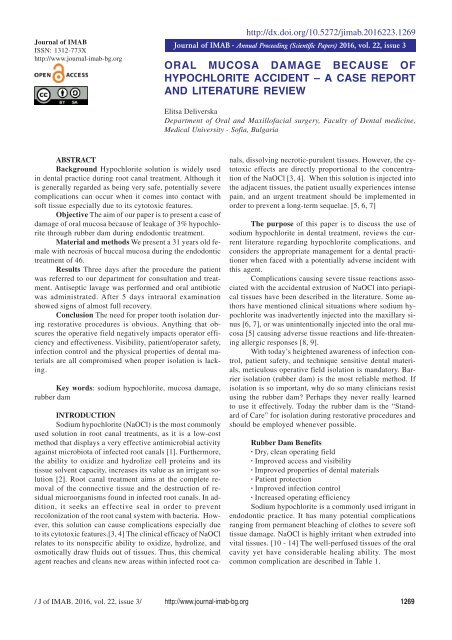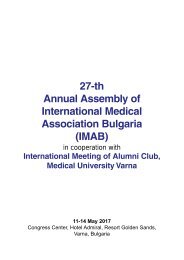JofIMAB-2016-vol22-issue3
Create successful ePaper yourself
Turn your PDF publications into a flip-book with our unique Google optimized e-Paper software.
Journal of IMAB<br />
ISSN: 1312-773X<br />
http://www.journal-imab-bg.org<br />
http://dx.doi.org/10.5272/jimab.<strong>2016</strong>223.1269<br />
Journal of IMAB - Annual Proceeding (Scientific Papers) <strong>2016</strong>, vol. 22, issue 3<br />
ORAL MUCOSA DAMAGE BECAUSE OF<br />
HYPOCHLORITE ACCIDENT – A CASE REPORT<br />
AND LITERATURE REVIEW<br />
Elitsa Deliverska<br />
Department of Oral and Maxillofacial surgery, Faculty of Dental medicine,<br />
Medical University - Sofia, Bulgaria<br />
ABSTRACT<br />
Background Hypochlorite solution is widely used<br />
in dental practice during root canal treatment. Although it<br />
is generally regarded as being very safe, potentially severe<br />
complications can occur when it comes into contact with<br />
soft tissue especially due to its cytotoxic features.<br />
Objective The aim of our paper is to present a case of<br />
damage of oral mucosa because of leakage of 3% hypochlorite<br />
through rubber dam during endodontic treatment.<br />
Material and methods We present a 31 years old female<br />
with necrosis of buccal mucosa during the endodontic<br />
treatment of 46.<br />
Results Three days after the procedure the patient<br />
was referred to our department for consultation and treatment.<br />
Antiseptic lavage was performed and oral antibiotic<br />
was administrated. After 5 days intraoral examination<br />
showed signs of almost full recovery.<br />
Conclusion The need for proper tooth isolation during<br />
restorative procedures is obvious. Anything that obscures<br />
the operative field negatively impacts operator efficiency<br />
and effectiveness. Visibility, patient/operator safety,<br />
infection control and the physical properties of dental materials<br />
are all compromised when proper isolation is lacking.<br />
Key words: sodium hypochlorite, mucosa damage,<br />
rubber dam<br />
INTRODUCTION<br />
Sodium hypochlorite (NaOCl) is the most commonly<br />
used solution in root canal treatments, as it is a low-cost<br />
method that displays a very effective antimicrobial activity<br />
against microbiota of infected root canals [1]. Furthermore,<br />
the ability to oxidize and hydrolize cell proteins and its<br />
tissue solvent capacity, increases its value as an irrigant solution<br />
[2]. Root canal treatment aims at the complete removal<br />
of the connective tissue and the destruction of residual<br />
microorganisms found in infected root canals. In addition,<br />
it seeks an effective seal in order to prevent<br />
recolonization of the root canal system with bacteria. However,<br />
this solution can cause complications especially due<br />
to its cytotoxic features.[3, 4] The clinical efficacy of NaOCl<br />
relates to its nonspecific ability to oxidize, hydrolize, and<br />
osmotically draw fluids out of tissues. Thus, this chemical<br />
agent reaches and cleans new areas within infected root canals,<br />
dissolving necrotic-purulent tissues. However, the cytotoxic<br />
effects are directly proportional to the concentration<br />
of the NaOCl [3, 4]. When this solution is injected into<br />
the adjacent tissues, the patient usually experiences intense<br />
pain, and an urgent treatment should be implemented in<br />
order to prevent a long-term sequelae. [5, 6, 7]<br />
The purpose of this paper is to discuss the use of<br />
sodium hypochlorite in dental treatment, reviews the current<br />
literature regarding hypochlorite complications, and<br />
considers the appropriate management for a dental practitioner<br />
when faced with a potentially adverse incident with<br />
this agent.<br />
Complications causing severe tissue reactions associated<br />
with the accidental extrusion of NaOCl into periapical<br />
tissues have been described in the literature. Some authors<br />
have mentioned clinical situations where sodium hypochlorite<br />
was inadvertently injected into the maxillary sinus<br />
[6, 7], or was unintentionally injected into the oral mucosa<br />
[5] causing adverse tissue reactions and life-threatening<br />
allergic responses [8, 9].<br />
With today’s heightened awareness of infection control,<br />
patient safety, and technique sensitive dental materials,<br />
meticulous operative field isolation is mandatory. Barrier<br />
isolation (rubber dam) is the most reliable method. If<br />
isolation is so important, why do so many clinicians resist<br />
using the rubber dam? Perhaps they never really learned<br />
to use it effectively. Today the rubber dam is the “Standard<br />
of Care” for isolation during restorative procedures and<br />
should be employed whenever possible.<br />
Rubber Dam Benefits<br />
· Dry, clean operating field<br />
· Improved access and visibility<br />
· Improved properties of dental materials<br />
· Patient protection<br />
· Improved infection control<br />
· Increased operating efficiency<br />
Sodium hypochlorite is a commonly used irrigant in<br />
endodontic practice. It has many potential complications<br />
ranging from permanent bleaching of clothes to severe soft<br />
tissue damage. NaOCl is highly irritant when extruded into<br />
vital tissues. [10 - 14] The well-perfused tissues of the oral<br />
cavity yet have considerable healing ability. The most<br />
common complication are described in Table 1.<br />
/ J of IMAB. <strong>2016</strong>, vol. 22, issue 3/ http://www.journal-imab-bg.org 1269



